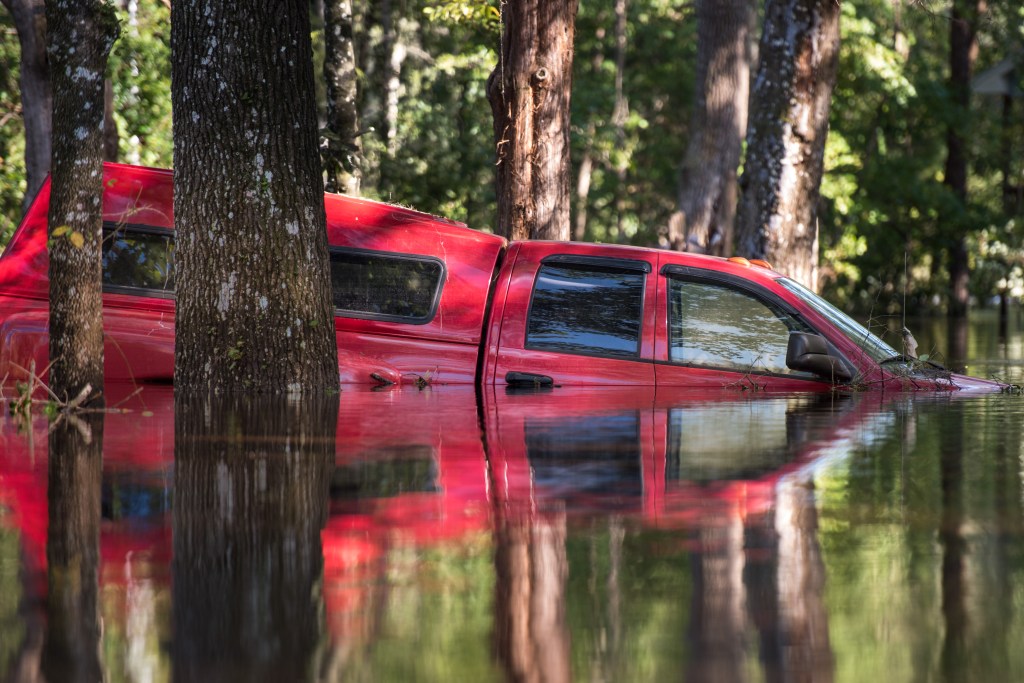In the wake of the unprecedented hurricanes that have slammed the Caribbean, Gulf, and southeast US, a litany of grim stats have begun to emerge that show the scale of their destruction. Tens of thousands of damaged cars litter the Houston area. According to the Pew Charitable Trusts, at least 190 schools in Harvey’s path have been damaged, displacing more than 15,000 students. In Florida alone, 6.2 million people were without power Sunday night.
But some are worried about a slightly hidden statistic: The number of properties covered by the National Flood Insurance Program (NFIP) hit by Harvey and Irma. Beyond the physical damage, the hurricanes may prompt a long-delayed showdown in Congress over one of the country’s most important but most dysfunctional tools for responding to disasters.
Videos by VICE
According to Pew Charitable Trust’s Flood-Prepared Communities program, Florida and Texas alone account for 57 percent of the US’s 5 million NFIP policies. Close to 1 million policyholders were in these states’ main disaster zones. Combined with policies in other affected regions—including Alabama, Georgia, Louisiana, Puerto Rico, South Carolina, and the US Virgin Islands—at least a quarter of all NFIP-covered properties in the nation could conceivably file a claim in the coming weeks and months.
“It’s too soon to tell what the impact from a financial perspective will be,” said Pew flood policy expert Laura Lightbody. But recent precedents suggest these claims will outstrip the NFIP’s funds. That’s bad. The question is whether Congress will fix that problem.
Congress created the NFIP in 1968 to give Americans in flood-prone areas access to affordable insurance after private firms largely stopped providing coverage. The program also aimed to encourage people to build sturdier homes or avoid development in flood zones, which it tried to do by charging higher premiums in riskier zones that it was responsible for mapping out and by forcing property owners to rebuild stronger structures or leave altogether after certain types of payouts.
The NFIP can make a huge difference in people’s lives. According to Lightbody, during the 2016 hurricane season individuals with NFIP insurance and valid claims got a $86,000 payout on average, while those without coverage but with real damages received an average of just $9,000 in recovery funds. “People who have flood insurance are just starting their recovery off on a much better foot,” she said. In theory, the program is a strong tool for disaster mitigation, especially as more people buy into it.
Unfortunately, the NFIP has become incredibly broken. Most of its maps are long outdated where they exist, which is only about a third of the nation according to Lightbody. This accounts in part for the lack of coverage in many affected regions—only 14 percent of homes in Florida’s declared disaster zones were in the NFIP, according to Pew. It also means that at least 20 percent of covered properties do not pay rates that actually reflect their risks.
The program has also failed to impose mitigation or relocation consequences on the vast majority of chronically flooded properties. As a result, the program pays out repeatedly for certain homes—at least 10 percent of properties that have made repeated claims have received more than their market value in payouts. Worse, 1 percent of all insured properties account for up to 25 percent of all payouts.
Despite these flaws, the NFIP remained solvent until 2004 by bringing in more in premiums than it paid out. But between climate change and under-regulated development expanding onto floodplains, this couldn’t last. The flaws in the program came to a head after Hurricane Katrina in 2005, which led to more than 167,000 paid claims, said Lightbody. Payouts on them totaled over $16 billion—more than the program could manage. After Katrina, the government was forced to authorize the NFIP to borrow up to $20 billion from the Treasury to pay claims. Hurricane Sandy forced that borrowing limit up to about $30 billion. Before these most recent hurricanes hit, the program was $25 billion in debt paying $400 million, or 11 percent of its premiums, in annual interest to the Treasury.
This leaves the NFIP with about $2 billion on hand, $5 billion it can borrow before it hits the statutory cap, and a little extra in reinsurance to cover Harvey and Irma’s aftermath. The claims will almost certainly dwarf those reserves. As of Monday, about 82,000 people had filed for claims in Harvey-hit regions alone, and that was just the first wave. Most analysts expect Harvey and Irma combined will trigger out far more claims and higher payouts than Katrina; provisional quotes put the expected NFIP payouts in the tens of billions.
That’s just a fraction of the total damages from Irma and Harvey, which some disaster assessment analysts have now estimated at as high as $290 billion. Even when it comes to handling flood damage, a lot of relief will come from other programs at more than a dozen government agencies, given the low NFIP coverage rates in affected zones.
But the NFIP is theoretically one of the most valuable tools for individual recovery in the wake of a hurricane. The fact that it seems bound to go bankrupt yet again shows just how dysfunctional the program has become.
“If there’s anything positive that has come from these disasters,” said Lightbody, “it’s that they have shined a national spotlight on the need to improve the National Flood Insurance Program. It forces Congress’s hand on addressing not only that borrowing limit, but the longer-term problems with the program—that it’s just not financially solvent.”
That might be wishful thinking. Those paying attention to the NFIP have floated many ideas about how to overhaul it: redrawing maps, raising rates to reflect actual risks, allowing private insurers to develop cost-effective policies. These ideas came up during the NFIP’s first post-Katrina reauthorization (a once-in-five-years event) in 2008. But debate was so fierce over what reforms to pursue and how to pursue them—with strong resistance from homeowners and developers who want to keep their costs down—that the NFIP couldn’t be reauthorized until 2012, requiring more than a dozen temporary extensions. Basic reforms passed that year, but backlash against rising premiums, among other provisions, after Sandy led to delays in those reforms being implemented in 2014.
The program was supposed to be reauthorized again by the end of this month, and reformers had spent years hashing out plans to fix the program. But those reforms were already stalled out, with no solution but an indefinite series of temporary extensions of the existing system in sight. Rather than pushing lawmakers to just swallow an existing reform program while the spotlight was on them after Harvey, Congress kicked the can down the road, pushing off reauthorization until December 8 in the same bill that appropriated the first tranche of hurricane relief funding.
Congress will have to revisit the subject then, and the need to address insolvency will force legislators to do more than just issue another short-term extension. But will they be able to tell people they can’t build in places likely to flood or face higher premiums? Or will they just order the NFIP to borrow more money? All that’s clear now is how massive these storms were, how severe a strain they will put on existing federal programs, and how ill-prepared the nation’s Political Establishment is to handle these strains.
Follow Mark Hay on Twitter.
More
From VICE
-

Margaret Norton/NBCU Photo Bank/NBCUniversal via Getty Images -

WWE via Getty Images -

Lexie Moreland/WWD via Getty Images -

Camp Snap
